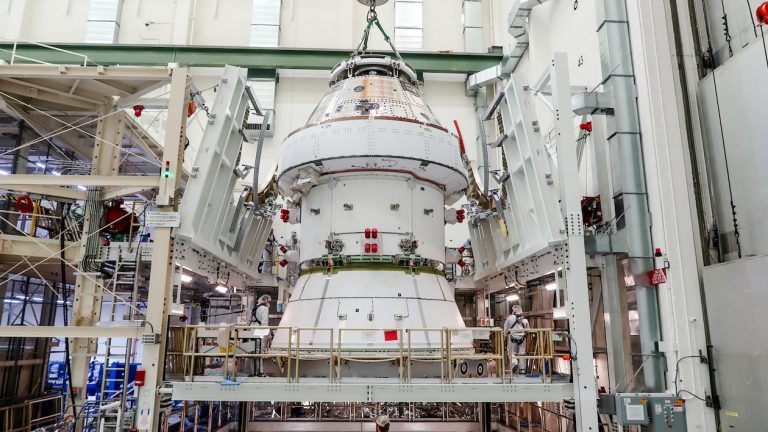
Next year, NASA will blast astronauts back to the moon. This is their 21st-century ride.
The European Space Agency — which helped build the Orion spacecraft that will carry four passengers — just posted an image of the tall vehicle before it was transferred to a test chamber for exposure to extreme, space-like environs.
“At NASA’s Kennedy Space Center in Florida, USA, the Orion vehicle that will be used for Artemis II is getting ready for this first mission to bring humans around the Moon and back in over 50 years,” ESA wrote.
The forthcoming Artemis II mission will see astronauts launch into space attached to NASA’s towering Space Launch System rocket, or SLS — a rocket more powerful than the Saturn V that first took astronauts to the moon. They’ll loop around the moon, but won’t land on it, before burning engines back to Earth and making a 5,000-degree plummet through the atmosphere. If the mission succeeds, it will pave the way for Artemis III in September 2026, which will touch down on the dusty lunar surface. They’ll stay for about a week.
The Orion craft below comprises four parts stacked together:
– Crew module: Up top is the crew module, where astronauts will live on their space flight.
– Crew module adapter: This segment connects the crew module to the crucial component below, the European Service Module.
– Service Module: ESA calls this the “powerhouse of Orion.” It provides electricity, propulsion, thermal control, air, and water, the agency explained.
– Spacecraft adaptor: At bottom, this conical segment connects Orion to the powerful SLS rocket.

Credit: NASA / A. Stevenson
NASA had previously expected Artemis II to launch in later 2024, but moved the flight back to September 2025 to address a few problems. Because there is life aboard, the agency — which knows all too well how a flight mishap can result in tragedy — values safety over expediency.
“Crew safety is and will remain our number one priority,” Amit Kshatriya, NASA’s deputy associate administrator of Exploration Systems Development, said in an agency statement earlier this year.
Of particular concern is the unexpected damage to Orion’s heat shield that occurred during the uncrewed Artemis I flight. Amid the hot descent through Earth’s atmosphere, some small pieces of the shield came off, as opposed to normal erosion from the intense friction and heat. “Teams have taken a methodical approach to understand the issue, including extensive sampling of the heat shield, testing, and review of data from sensors and imagery,” NASA explained.
As looming Artemis missions aboard Orion take flight, NASA’s aims are distinctly different than that of the legendary Apollo missions of over 50 years ago. This time, NASA will establish a permanent presence on and around the moon. And for the first time, astronauts will venture into the lunar south pole, a place scientists think contains bounties of water ice — a critical resource for fuel and water in any moon colony.






















0 Comments